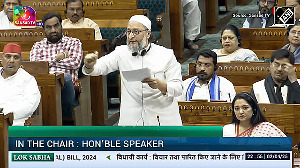Evaluating mutual fund performance is always an exercise fraught with risks. Funds, which performed best in terms of absolute returns may not necessarily be the most consistent over longer periods of time.
And if you are looking at annualised returns, abnormally high returns in a rising market may help a fund post averages higher than the rest, regardless of whether it managed to perform consistently over several years running.
While there is no better benchmark than performance, investors would do well to keep in mind the consistency factor also.
And the winners are...
A look at the performance of equity diversified schemes over a one-year period ended February 28, 2005, tells us that SBI Mutual Fund's Magnum Global scheme is on top of the heap as far as returns for the period go, at 84.49 per cent, followed by another scheme of SBI -- SBI Magnum Sector Umbrella -- Contra Fund, at 80.78 per cent.
The next three in the list are Taurus Starshare (66.43 per cent), Sundaram Select Mid Cap (63.86 per cent) and Franklin India Prima Fund (61.88 per cent). These funds have also managed to outperform the benchmark Sensex by a mile. For the record, the Sensex recorded a return of 18.35 per cent over the past one year.
"We are not merely looking at absolute returns per se. Our aim is to do better than the peer set while trying to beat the index," notes Rajat Jain, chief investment officer of Principal Mutual Fund, whose Principal Growth Fund gave a return of 49.64 per cent.
When one looks at compounded annualised returns for periods above one year, we get a different picture. For the two-year period, well-known funds like Franklin India Prima Fund (99.34 per cent) and Reliance Growth Fund (98.43 per cent) come out on top.
SBI's top performing funds, Magnum Sector Umbrella -- Contra and Magnum Global, have done well over here, too, giving returns of 95.32 per cent and 92.87 per cent respectively.
In fact, the former is the best performing diversified fund over a five-year period, too, with returns of 26.19 per cent, followed by Franklin India Prima Fund (24.83 per cent), Reliance Vision (24.76 per cent), Reliance Growth (20.69 per cent) and HDFC Capital Builder (20.18 per cent).
When you look at the compounded annualised return for the Sensex for the five-year period, which is at 3.18 per cent, the performance of these schemes stands out.
Look for consistency
The problem is -- as we noted earlier -- annualised returns may be skewed by an abnormal return during any year in the timeframe of return calculation. That way funds which have consistently beaten the markets over the years, without giving abnormally high returns during any period, tend to be lower down the order.
Also while one fund manager may have played it cautious by investing in good quality stocks over the years and given a return of, say, 20 per cent over a five-year period, another one who invested in speculative stocks or small-caps in one year may have struck it rich in that year, thereby outperforming the former by a long way.
Thus it is important to look at consistency of returns over a period of time rather than going by absolute returns generated in the short term, or even one or two years.
A look at the top 25 schemes in terms of absolute returns over the one-year period ended February 28, 2005, and their consistency over the past five calendar years throws up a different picture altogether.
There are few schemes, which have consistently managed to beat the index over the past years. The most notable among them being HDFC Capital Builder, which topped the charts in 2004, Franklin India Prima Fund, the 2003 topper and Reliance Growth (best in 2002).
While these funds have consistently managed to stay in the top 10, others like HSBC Equity Fund, Alliance Equity Fund, DSP ML Opportunities and Principal Growth also have performed admirably.
HDFC Capital Builder has managed to beat the index in five of the six years under consideration, the only aberration coming in 2001. Franklin India Prima also managed to stay ahead of the index five of six times, missing out only in 2000, when the tech bubble burst. As for Reliance Growth, it has been an outperformer four of six times.
The way to the top
But to be fair, funds like SBI Magnum Global and SBI Magnum Umbrella - Contra have been performing remarkably well over the past year.
In fact, the former is the number one in terms of return for the past six months, while it is lying at number five for the three-month period ended February 28, 2005. Similarly the latter ranks in the top five for the three-month and six-month periods.
A look at the portfolios of these schemes shows active churning in the past year. While SBI Magnum Global had auto, auto ancillaries, steel and petro stocks dominating its portfolio in February 2004, one year hence it has shifted focus to mostly infrastructure and related stocks.
The fund's portfolio has been mostly mid-cap oriented in the past year with the current top holdings being Crompton Greaves, Jaiprakash Industries and Shree Cement.
The fund has also booked profits in scrips like Maruti Udyog, Tata Steel and L&T, which have seen a huge run-up in 2004. SBI's other top performing scheme, Magnum Umbrella -- Contra has also seen changes over the past year, with focus shifting from top holdings like Tata Steel, Maruti Udyog, Bhel and HPCL to banking and auto stocks like SBI and Mahindra & Mahindra.
This fund has also taken a big bet on infrastructure with stocks like IVRCL Infrastructure and Nagarjuna Constructions finding a prominent place in the latest portfolio.
However, Taurus Starshare's portfolio makes for interesting reading. The fund has 30 per cent -- no less -- of its portfolio in a finance company called J P Associates. The rest of the portfolio is rather tame in comparison, with Crompton Greaves, Ceat and NDTV occupying the next three slots.
While short-term trends should never be a criterion for evaluating fund performance, they can in the least act as a pointer to emerging trends. The three-month performance table (from December 2004 to February 2005) throws up even more interesting winners.
The topper is GIC Mutual Fund's GIC Growth Plus II, followed by Escorts Growth Plan of Escorts Mutual Fund. While Escorts Growth Plan's big exposure to scrips like Jindal Iron & Steel and L&T and Bajaj Hindustan seems to have paid of, higher allocations to stocks like Petronet LNG and Galaxy Entertainment have worked in GIC Growth Plus's favour.
With equity diversified funds coming to the fore once more, fund managers are betting on them for the future, too.
"I believe diversified equity funds will do well going forward. Investors can take sectoral bets as an add-on to their diversified portfolio. First, you have got to be in the market, then you can add sectoral allocation if something looks attractive," says Jain.
Sectoral winners
Among sectoral funds, banking sector funds - though only two in number - have been the best in the past one-year. The category has given a return of 50.69 per cent for the past one-year period, followed by FMCG sectoral funds at 49.75 per cent and ELSS funds (46.75 per cent).
In fact, diversified funds (38.19 per cent) rank below technology funds (45.24 per cent), which finds itself at the fourth position. Pharma funds, meanwhile, have given a return of 34.09 per cent. Petro funds, which not so long were topping the charts, are now languishing at the bottom due to volatile oil prices, managing returns of only 8.14 per cent for the past year.
Outlook
Given the euphoria about equities (forgetting the slide seen over the past few days), it is not surprising that fund managers continue to remain upbeat.
"From a one- to two-year perspective, there is a clear case for a re-rating of Indian markets. I believe that valuations of Indian markets (14x) have been playing catch-up vis-à-vis corporate earnings growth," says Tridib Pathak, chief investment officer of Cholamandalam Mutual Fund.
According to Pathak, confidence in the Indian markets is on the rise and continuing improvements in domestic liquidity as well as FII inflows should ensure an expansion of market P/Es. "The leap of faith in the markets is very visible."
However, despite the optimism, fund managers warn against sky-high expectations. "One should not expect 40-50 per cent returns year after year," cautions Pathak.
"I believe that investors can expect at least 12-15 per cent returns from equities going forward, which compares well with 5-6 per cent returns that are provided by other investment classes," says Pathak.
Debt funds
In debt fund categories, short-term funds (4.80 per cent) continue to rule the roost, followed closely by floating rate funds (4.78 per cent). Income funds and gilt funds continue to languish.
Among short-term funds, Prudential ICICI Short Term Plan, Reliance Short Term Fund and Tata Short Term Bond Fund have managed the best returns in the past one-year as well as for the six-month period.
As for income funds, Libra Bond Fund and Prudential ICICI Long Term Plan (cumulative) have managed to beat their peers by a long way. While the former posted returns of 11.09 per cent for the past one year, the latter recorded 10.69 per cent.
However, these funds have a corpus of less than Rs 2 crore (Rs 20 million). But such exceptions apart, income fund returns have largely been in a band of 5.25-1.25 per cent.
But as far as consistency of performance goes, the top performers during the period under review have been found lacking -- as in equities. For example, Libra Bond Fund, Prudential ICICI Long Term Plan (cumulative) and BoB Income Fund are ranked in the top three as far as 2004 returns are concerned.
However, when you look at the returns for the calendar year 2003, they have badly misfired. While Libra is the last among the top 25 schemes (as per February 28, 2004, returns), BoB is the second last. The Prudential scheme managed to be in the top 10 at number nine. The message is: if you are looking for consistency, look somewhere else.
For example, schemes like JM Income (topper in 2002), Escorts Income Plan (topper in 2003) and Kotak Bond Regular Plan (leader in 2000) have proved to be far more consistent.
An interesting aside is that Principal PNB Debt Fund, which was the overall bond fund topper for three consecutive years ending 2002, finds itself at the bottom in 2004, essentially because it relied heavily on government securities to perk up returns in the earlier years.
As for the others, MIPs have also managed to do well in the past year, with the average returns being 6.28 per cent. Higher exposure to equities has obviously helped improve performance. Leading MIP schemes like HDFC MIP and FT MIP have given return above 9 per cent.
One positive aspect has been that income fund returns are showing an improvement in the short-term. So is the worst over for debt funds? Not really.
"Even though the markets have been volatile, most funds have managed to stay afloat. Bond fund managers have reduced their maturity profiles and are carrying short-duration papers in their portfolio," explains Mahendra Jajoo, head of fixed income at ABN Amro Mutual Fund.
According to Jajoo, the funds, which have attempted duration management have not done well. So will short-term funds continue to outperform their long-term peers going forward?
"I expect liquid funds will outperform other debt fund categories going forward. With the prospect of global interest rates inching upwards, the outlook on income funds is not too good," says Jajoo.








 © 2025
© 2025